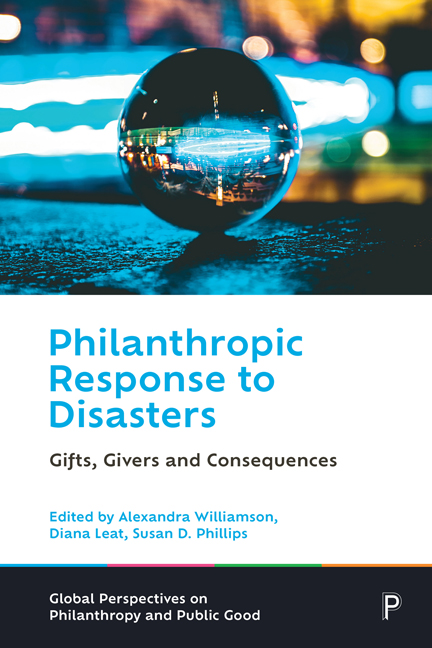Book contents
- Frontmatter
- Contents
- List of tables and figures
- Notes on contributors
- Series editors’ preface
- 1 Introduction
- 2 The public’s philanthropic response to disaster: plus ça change?
- 3 Disaster fundraising: readiness matters
- 4 Roles of philanthropic foundations as funders and distribution agents in disaster response
- 5 The private sector and disasters: from reactive response to disaster resilience
- 6 Fundraising, grantmaking and regulatory issues: regulating good in bad times
- 7 Doing good better: public policy for disaster philanthropy
- 8 Philanthropy’s place in community-based capacity development for disaster resilience
- 9 Nonprofit collaboration and coordination in disaster response: lessons from the 11 September recovery
- 10 The promise and reality of philanthropy in disasters
- 11 Conclusions and looking forward
- Index
5 - The private sector and disasters: from reactive response to disaster resilience
Published online by Cambridge University Press: 17 January 2024
- Frontmatter
- Contents
- List of tables and figures
- Notes on contributors
- Series editors’ preface
- 1 Introduction
- 2 The public’s philanthropic response to disaster: plus ça change?
- 3 Disaster fundraising: readiness matters
- 4 Roles of philanthropic foundations as funders and distribution agents in disaster response
- 5 The private sector and disasters: from reactive response to disaster resilience
- 6 Fundraising, grantmaking and regulatory issues: regulating good in bad times
- 7 Doing good better: public policy for disaster philanthropy
- 8 Philanthropy’s place in community-based capacity development for disaster resilience
- 9 Nonprofit collaboration and coordination in disaster response: lessons from the 11 September recovery
- 10 The promise and reality of philanthropy in disasters
- 11 Conclusions and looking forward
- Index
Summary
Introduction
In recent times there has been considerable concern that natural hazards are occurring more frequently, are more complex and on an ever-larger scale. While losses and damages from natural hazard events have been historically significant, atmospheric scientists warn that higher moisture deficits, temperatures and wind speeds are increasing the likelihood that, across the globe, communities will face ‘unknown and unknowable’ weather patterns (Chow and Sarin, 2002, p 127). Similarly, other threats associated with global environmental degradation, including the recent COVID-19 pandemic, illustrate that we are in an era in which emergencies, risks and disasters will only increase. Consequently, policymakers and practitioners have come together to begin to address these concerns through the Sendai Framework for Disaster Risk Reduction 2015– 2030 (SFDRR) (UNDRR, 2015) to bolster disaster resilience among communities worldwide. SFDRR requires ‘the adoption of policies, strategies and plans and the further review and development of normative instruments at local, national, regional and global levels as well as quality standards and practical guidelines’ (UNDRR, 2015, p 3).
While SFDRR represents a turning point for governance systems and public management of disasters, less attention has been accorded to the implications for the private sector generally. More specifically, the way in which the private sector supports disaster-affected communities, not only in the response phase but also in preparedness, planning and recovery, is less considered.
This reflects a wider gap in the literature, which has historically tended to focus on the role of governments and public agencies, including emergency services in disaster response. Where research has addressed non-governmental action it has tended to focus on the role of the community and the not for-profit sector in responding, in unison with and independently of public agencies (Kapucu, 2016). Significantly less attention has been accorded to how for-profit actors are integrated into disaster response, recovery and mitigation (McKnight and Linnenluecke, 2016). Furthermore, where the private sector – which we define as extending from individual entrepreneurs to small to medium-sized (SMEs) enterprises to large privately held and publicly listed companies – has been studied, it has been with a focus on philanthropic responses through donations (including cash, goods and/ or services).
- Type
- Chapter
- Information
- Philanthropic Response to DisastersGifts, Givers and Consequences, pp. 91 - 108Publisher: Bristol University PressPrint publication year: 2023



